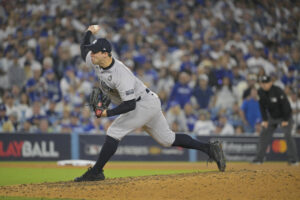It’s funny how we watch the game we love and don’t wonder about its beginnings. From Abner Doubleday to the stirrup sock to sunflower seeds in the dugout. When did they become part of the game and how were they added? This is the story of one such tiny facet of the game. For this one, we have to look back over a hundred years.
His Credentials
Charles Albert or Chief Bender as he became known was born in Crow Wing County, Minnesota on May 5, 1884. Born of an Ojibwe mother and a white father, his Native American heritage would be the first impression most people had of him. Those that knew and competed against him, however, came away with quite a different view. Bender took his own path at the age of fourteen when he ran away from home to work as a hand on a large farm. From there he was recruited to attend the Carlisle Indian School in Pennsylvania some years before Jim Thorpe made it famous. While a student, Bender excelled in baseball and would go to Harrisburg, Pennsylvania to play semipro baseball following his 1902 graduation.
That is where a scout for the Philadelphia AthleticsOakland Athletics: Team News, Analysis, Schedule, History found him and made Bender an offer. The lanky right-hander joined Connie Mack’s team in 1903 at the age of 19 and was off to the races. Bender would pitch 16 seasons and compile a 212-127 record and a career 2.46 ERA. His exploits include a no-hitter, pitching three complete games in one World Series and a postseason record of 6-4, nine complete games, and a 2.44 ERA.
His Struggle
From the moment he walked into a Major League ballpark, Charles Albert Bender was at a disadvantage. As a Native American, he faced racial bigotry that was commonplace. It permeated everything he did. Even newspaper coverage of the time could not praise him for outstanding performance without making reference to his heritage. Bender, like virtually every Native American of any prominence, was popularly called “Chief”, a nickname he did not care for in the least. On the field, there was a regular stream of references from opponents toward Bender demeaning his intelligence and ability to understand English.
Fans of the time were no less kind. Bender heard the chirping of inept war whoops and jeers wondering if his head-dress was in his locker. Through it all the tall and lean right-hander remained largely stoic. Although it’s known that occasionally Bender would smile and shout “Foreigners! Foreigners!” to the crowd. It demonstrates an intelligence and grace anyone who knew him well remembered about Bender.
Hall Of Fame Abilities
Teammates revered Bender for his pleasantness, intelligence, and poise under pressure. His studious nature was a key to his success it seems. After closely studying the legendary Christy Mathewson, Bender was able to hone his pitch command. He was renown for being one of the country’s best trap shooters claiming it kept his eyesight sharp for pitching. Keen observation skills from the bench allowed Chief Bender to pick out the tendencies of opposing players. He found holes in opponents’ swings and knew when they would try to steal a base. The Minnesotan claimed gold was easy because he was used to doing the same thing over and over when pitching. An early reference to what we now call muscle memory.
It was in this acute intelligence that Bender found ways to win that were admittedly beyond his physical talents. He faced numerous health issues throughout his career and his level of drinking increased as his career went on. Through it all Bender succeeded and became one of the top pitchers in his time. One tool he used to do it was a pitch unlike any other of the era.
The Nickel Curve
Something Charles Albert Bender noticed during his observations was that there was very little variation in the pitches thrown by almost every pitcher in the game. Hurlers threw the fastball and the slow ball (an early name for a change-up). Most had a curve of some sort and a few mixed in spitballs which were still legal at the time. Everyone looked fairly similar. Bender realized that there was room for innovation and eventually figured out what he would do.
His solution was the “nickel curve”. It was called that because it was a regular curveball that broke a dime’s worth and Bender’s curve only broke worth a nickel. Bender achieved a unique movement by throwing his curve much harder than usual. It’s not known if he changed the grip of the pitch, but Bender always referred to it as his “hard curve”. Coupled with his command cool demeanor under pressure, the nickel curve was a difference-maker.
Bender’s Legacy
The descriptions of Bender’s hard/nickel curve were that it broke somewhat like a curve but was nearly as fast as a fastball. An assessment sounding much like the modern-day slider. The debate over who originated the slider amongst some is whether George Blaeholder or George Uhle came up with it in the 1930s. Both right-handers possessed a pitch that came in like a fastball but had a late break that rode in on the hands of left-handed hitters. The descriptions were that both moved largely only on the horizontal plane. Bender’s pitch regularly broke both the horizontal and vertical planes. That made it more of a forerunner of the slider and as many as thirty years earlier.
Whether or not he can be credited with the invention of the slider or not, Bender’s true legacy was that as a true renaissance man. He came from dirt poor beginnings to the Hall of Fame. Those that knew him best told of a keenly intelligent, pleasant man worthy of their respect. Legendary manager Connie Mack recognized those qualities and referred to Bender as “Albert”, never giving in to the prejudices of the time. Bender was a meticulous gardener, painted landscapes, and was successful in sporting goods and men’s clothing sales. Over a hundred years later, his records have faded from memory. But it’s his strong connection to the origins of the slider, a staple of the game to this day, that makes Charles Albert Bender worthy of every baseball fan’s notice.
Main Image Embed from Getty Images






